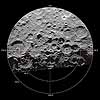| . |  |
. |
The discovery of accessible deposits of water on the moon would "profoundly" affect the economics and viability of a lunar base, Cornell University astronomer Donald Campbell told a House of Representatives subcommittee today, April 1. Unfortunately, he said, recovering water deposits will not be an easy task, since they are likely to exist in the bottoms of very cold, permanently dark craters at the moon's poles. "For a permanent or reusable base, a local supply would be invaluable both for human needs in the form of water and oxygen and for production of rocket fuel," Campbell told the House subcommittee on space at a hearing on "Lunar Science and Resources" in the Rayburn House Office Building. In January President George Bush announced a goal of returning humans to the moon by the end of the next decade and using a lunar base as a launch pad to Mars. The president said he would seek an additional $1 billion over the next five years to begin research on the program, and he directed NASA to divert $11 billion from existing programs to support development of technology needed to reach the moon and Mars. Campbell is professor of astronomy at Cornell and associate director of the National Astronomy and Ionosphere Center, based at Cornell, which operates Arecibo Observatory, Puerto Rico, for the National Science Foundation. A viable lunar base, Campbell told the committee, would enable further exploration of the moon and "has the potential to allow exploitation of lunar resources." These resources, he said, include a variety of minerals, such as oxides of iron and titanium, "and it is possible that these minerals can be utilized to provide resources such as oxygen to sustain an extended human presence on the moon." Campbell spent much of his testimony discussing the possibility that water is trapped below the lunar surface. Over the past decade, he said, there has been evidence from instruments on lunar orbiting spacecraft suggestive of the presence of water ice in the polar regions. Suggestions of lunar ice first came in 1996 when radio data from the Clementine spacecraft gave some indications of the presence of ice on the wall of a crater at the moon's south pole. Then, neutron spectrometer data from the Lunar Prospector spacecraft, launched in 1998, indicated the presence of hydrogen, and by inference, water, at a depth of about a meter at the lunar poles. But radar probes by the 12-cm-wavelength radar at Arecibo showed no evidence of thick ice at depths of up to a meter. However, Campbell told the committee, "While perhaps unlikely, the possibility still exists that there are thick ice deposits in the bottoms of some shaded impact craters at the lunar poles." There are definitely higher concentrations of hydrogen at the lunar poles compared with other areas of the moon, he said, "but both its origin - and its current form - hydrogen, ice or hydrated minerals - is a topic of considerable discussion in the relevant scientific community." He warned that "before we spend too much time making plans for exploiting water resources on the moon, we should determine whether there are any recoverable deposits of water, in what form - distributed at low concentrations in the lunar soil or in concentrated deposits - of what type - ice or hydrated minerals - and how accessible." To do this, he said, it will be necessary to send one or more missions with these specific objectives. Related Links Campbell Testimony in full SpaceDaily Search SpaceDaily Subscribe To SpaceDaily Express  Tucson - Mar 31, 2004
Tucson - Mar 31, 2004Two University of Arizona planetary scientists will testify this week before the House Subcommittee on Space and Aeronautics. The subcommittee is studying the feasibility of lunar-based scientific and commercial activities. Lunar Polar Ice Not Found With Arecibo Radar  Arecibo - Nov 13, 2003
Arecibo - Nov 13, 2003Despite evidence from two space probes in the 1990s, radar astronomers say they can find no signs of thick ice at the moon's poles. If there is water at the lunar poles, the researchers say, it is widely scattered and permanently frozen inside the dust layers, something akin to terrestrial permafrost.
|
| ||||||||||
| The content herein, unless otherwise known to be public domain, are Copyright 1995-2016 - Space Media Network. All websites are published in Australia and are solely subject to Australian law and governed by Fair Use principals for news reporting and research purposes. AFP, UPI and IANS news wire stories are copyright Agence France-Presse, United Press International and Indo-Asia News Service. ESA news reports are copyright European Space Agency. All NASA sourced material is public domain. Additional copyrights may apply in whole or part to other bona fide parties. Advertising does not imply endorsement, agreement or approval of any opinions, statements or information provided by Space Media Network on any Web page published or hosted by Space Media Network. Privacy Statement All images and articles appearing on Space Media Network have been edited or digitally altered in some way. Any requests to remove copyright material will be acted upon in a timely and appropriate manner. Any attempt to extort money from Space Media Network will be ignored and reported to Australian Law Enforcement Agencies as a potential case of financial fraud involving the use of a telephonic carriage device or postal service. |